Deep learning is not an illusion. The following ten exponential growth trends prove that deep learning has achieved rapid development in the past year and has become the “top pillar†of current artificial intelligence. This article analyzes the top-level academic conferences such as ImageNet, NIPS, and CVPR, as well as enterprise applications such as Google and Nvidia, as well as in-depth study of talents, investment, and acquisitions.
Exponential growth of image recognition accuracy
It seems that everything started from the ImageNet Challenge in 2015, when the machine surpassed humans for the first time in image recognition accuracy, it was considered a milestone breakthrough.
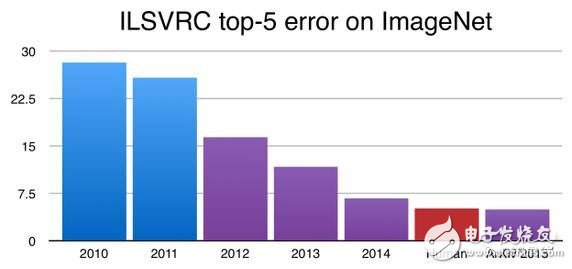
Figure: ILSVRC top-5 error rate
The image recognition error rate of the algorithm in 2010 is at least 25%, but by 2015, the computer image recognition error rate is already lower than that of humans (human level is about 4%). 2015 is 0.03567, which is 3.5%. In 2016, ImageNet competition, the image recognition error rate further declined, the error rate this year's best score: the average error rate of 0.02991, which is about 2.99%.

As can be seen from the above figure, in the ImageNet competition, in fact, from 2012, using the deep learning method, the error rate is only about 15.3%. This is the result of Professor Hinton and his two graduate students Alex Krizhevsky, Illya Sutskever. It is said that they used two Nvidia GTX 580 CPUs (3GB of memory, 1.6 TFLOPS), which allowed the program to receive 1.2 million image trainings, which took nearly six days.
Exponential growth in search heat
“Deep Learning†began to emerge in 2012. The image below shows the search trend for “Deep Learning†in Google Trends.

Deep learning has become a veritable hot word in the past two years.
Exponential growth of in-depth learning influence at academic conferences
Reality shows that academic research is indeed experiencing explosive growth
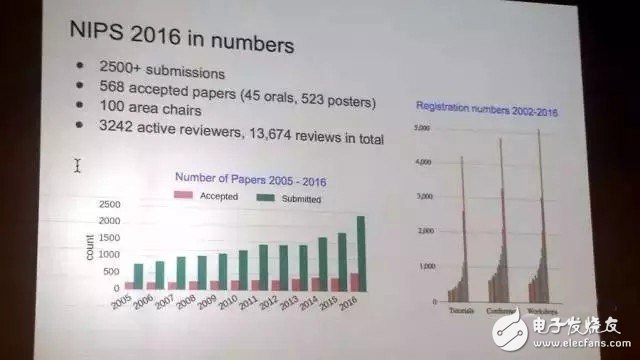
Figure: NIPS growth trend
In 2016, NIPS, which was the top event in the academic world, received more than 2,500 submissions and eventually received 568 articles – a conservative estimate of 22.7%. The acceptance rate of this paper is not so low (compared to other top meetings).
Looking at the number of participants and their recent growth trends (above), the number of participants in 2016 has exceeded 5,000 – especially in the past two years. It is no exaggeration to describe it as “straight upâ€.
CVPR is the international top conference in the field of computer vision. The following is a growth trend chart for CVPR:

Figure: Trends in the number of CVPR participants
According to previous reports by Xinzhiyuan, 2145 papers were received in this session, setting a historical record (effective 1865 articles). The conference received 643 papers (receiving rate 29.9%).
Among the papers received at the 2016 CVPR conference, 80% to 90% of the papers published, and nearly 100% of the oral reports are from the field of deep learning.
Exponential growth of deep learning technology within the enterprise
The above can show the growth trend of deep learning theory. But is it only theory? Let's take a look at the use of deep learning technology inside Google.

Figure: Google’s trend of using deep learning
As can be seen from the above figure, between 2014 and 2015, the use of deep learning technology within Google has shown a rising trend. Applications include: APP, maps, photos, email, voice, Android, Youtube, translation, robotics research, image understanding, natural language understanding, drug detection.
In his interview with Forbes, Google brain head Jeff Dean mentioned that between 2011 and 2012, the company used only a dozen teams of deep neural network technology. Now there are more than 200 groups and thousands of people are training. This type of model uses software built by the Google brain team.
He said: "Five years ago, when we first started to set up a machine learning research group to investigate the use of a large number of computational and deep convolutional networks to deal with problems, not many people in the company were using this method. Later, We found a few places that seemed to be effective, including speech recognition systems, so we worked closely with our colleagues in the speech recognition team to add deep neural networks to the speech recognition system to gain recognition accuracy. Significant improvements. Then, we worked with several computer vision-related teams, such as image recognition and some Street View teams, including using the original pixels in the image to train the model to do some interesting things, extracting text from the image or Understand the image (a jaguar, a garbage truck or something else).
Interestingly, over time, more teams are adopting these methods because they will hear other teams say they are trying something else and get good results. Otherwise, we can associate them with these teams, or we can provide some advice on how to use them in their specific problem context. Later, we formalized these, so now we have a team to do these extensions. The first is to contact the team that wants to use these machine learning models in the product. They will describe the problems they have encountered. In general, our team will say: "This seems to be similar to the problems encountered by other teams. We The solution is very useful, try our solution and give us feedback."
In-depth growth in demand for deep learning talent
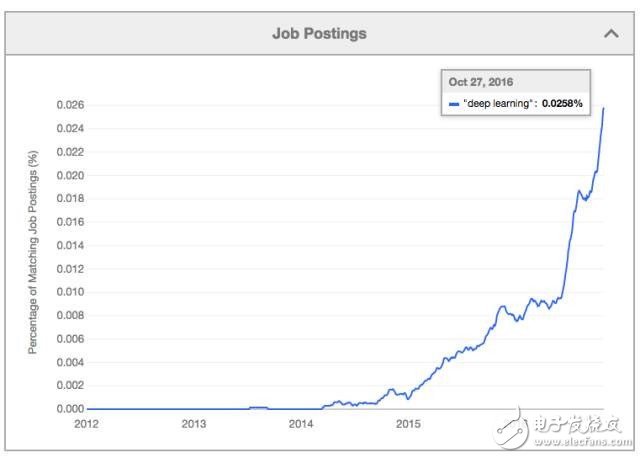
Since 2015, the demand for deep learning talents has risen sharply in the market, and in the second half of 2016, it has increased by a large margin. In addition, since 2015, we have also seen a large number of top talents in the academic world flowing to the industry.
Exponential growth in deep learning investment

Figure: Investment in AI technology companies has increased year by year in recent years
During the second quarter of 2016, the region with the largest amount of financing transactions was the United States, with 47 transactions in total, with a total financing amount of $524.5 million.
In addition to the United States, 15 countries and regions in the world have participated in equity investment and financing activities of AI-related companies in the second quarter of 2016, including China (and Hong Kong), India, Sweden, Ukraine, France and Canada.
Among them, Canada, the United Kingdom, Israel, Germany, AI field investment is relatively active, especially a few transactions worth noting: In Canada, GE Ventures participated in the two rounds of BitStew Systems C financing, the main business of the industrial Internet of Things ( IIoT) data analysis platform; in London, UK, Lerer Hippeau Ventures, Bloomberg Beta and Salesforce Ventures participated in the seed round financing of DigitalGenius, which mainly provides AI solutions for customer service; in Israel, Alibaba Group invested in e-commerce The search found the A-round financing of the startup Twiggle, while the investment institutions including Khosla Ventures and Marc Benioff supported the B-round financing of the medical startup Zebra Medical Vision; in Germany, New Enterprise Associates participated in the A-round financing of Konux. The startup provides sensor solutions based on AI technology to the industry.
Exponential growth in large company acquisitions

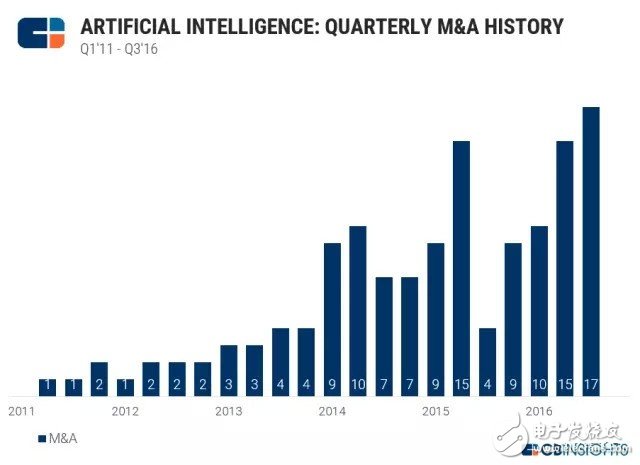
Artificial Intelligence Enterprise M&A History
In 2016, every quarter, there were at least 10 mergers and acquisitions about artificial intelligence. This exponential growth trend has started in 2014 and there is no downward trend.
In 2016, some very high-profile acquisitions took place in the AI ​​space, including the $150 million publicly available Twitter in June to acquire Magic Pony Technology, a machine that focuses on visual processing (machine). Learning) algorithm technology company. In August, Intel acquired Nervana for more than 4 dollars.
Among them, 2016 has also become Intel's transition to artificial intelligence and deep learning. Intel vice president Jason Waxman said in an interview with Recode that the transition to artificial intelligence may damage Intel's efforts to enter the cloud. But Waxman also emphasized the importance of machine learning. He said machine learning is very important as Intel transforms from a user-controlled network of devices to the world and a world in which billions of devices are connected and talk to each other.
Volkswagen's exponential growth in investment
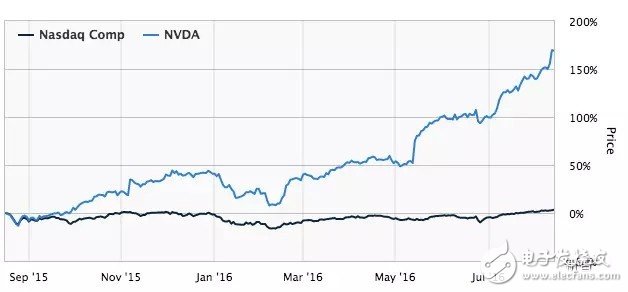
The development of artificial intelligence, especially deep learning, has greatly promoted the rise of Nvidia's share price. Since 2015, NVIDIA's share price has been higher than the Nasdaq average.
According to the latest information, Nvidia's third-quarter 2016 financial report reported a significant increase in revenue in the quarter, far exceeding market expectations. After the earnings report, Nvidia's share price rose nearly 30% to 87.97 US dollars, a record high. NVIDIA's share price has continued to rise since September 2015, and the increase has more than tripled.
In August of this year, CEO Huang Renxun emphasized at the investor conference that deep learning is a very important growth driver for NVIDIA and an area in which the company has continued to invest heavily. “In the past five years, we have been quietly investing in deep learning because we believe in deep learning of the future. It has a profound impact on the entire software industry and the entire computer industry. We have all been bet on deep learning."
Huang Renxun also pointed out that about half of Nvidia's data center business is a deep learning system, which is also due to the company's strong investment in deep learning chips.
Is deep learning the main driver of AI?

The above picture is a search trend for artificial intelligence and deep learning in the past 5 years in "Google Trend". Blue is "deep learning" and red is "artificial intelligence". “Deep learning†is less than “artificial intelligence†in total, but the growth trend is very obvious and has recently become closer. And, from the perspective of growth, deep learning growth is very obvious.
Finally, the most important trend

The "intellectual" level of artificial intelligence is growing, and the future may surpass the human level of humans and even high intelligence. However, it seems that the level of intelligence of artificial intelligence is only better than that of ants. (Photo from Wait Buy Why).
Din Rail Fuse Terminal Block,Screw Fuse Terminal Block,Din Rail Fuse Holder Terminals,Din Rail Fuse Terminal
Wonke Electric CO.,Ltd. , https://www.wkdq-electric.com